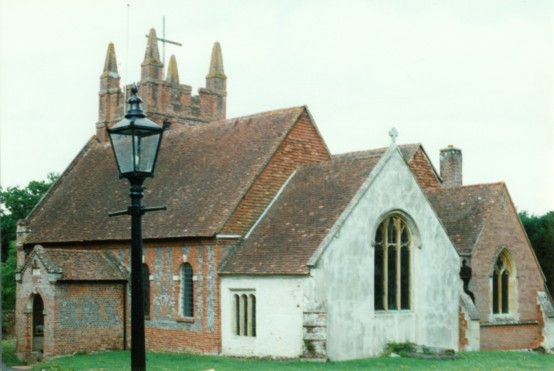
St Mary's, Eversley, Hampshire - a place of worship for over 900 years
The St Mary's Church Eversley, Hampshire -
Pagan Stone Beneath Altar Floor Mystery.
From late Antiquity and throughout the Middle Ages, pagan sites were invariably Christianized in some way.
This was first achieved through church propaganda, publicly condemning pagan temples and practices; next came the demolition of pre-Christian establishments - then the erection of buildings for Christian worship directly over their foundations.
Yet things were not always as clear cut as this; there is evidence to suggest that those who controlled the churches' governing structure, were split over the Christianization of sites, and that concessions were sometimes made to paganism; this included the incorporation of earth worship iconography in churches, such as foliate man... decorative carvings in stone and on wooden bench ends; but on rare occasions, an even great compromise was struck; this involved ancient standing stones deliberately being left in situ during the construction of churchyards - and even more bizarrely, sometimes being incorporated into the very fabric of churches themselves!
Effectively, this practice was 'permitted' in order to attract pagan folk away from their traditional ways of worshiping stones and trees, and persuading them to go into these shiny new edifices called churches; but maybe there was also an element of superstition going on here by the architects; and dare we say it - even some clerics who may have flirted with (or at least had a soft spot for), nature worship beliefs.
This mix of Christian and Pagan within early churches is certainly not an uncommon phenomenon, and one superb example can be found at St Mary's, Eversley, Hampshire, England.
Beneath a secreted hatch in the floor, right by the font, there exists an ancient megalith!
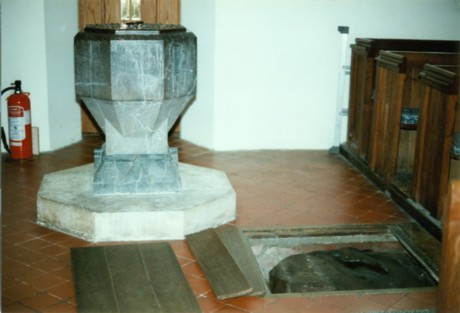
A pagan standing stone in the floor by a Christian font!
It's as if St Mary's has been built around this stone - yet it is kept hidden... why?
Interesting, considering how originally, sarsen standing stones were of as much sacred importance to the pagans, as the later church fonts were to Christians.
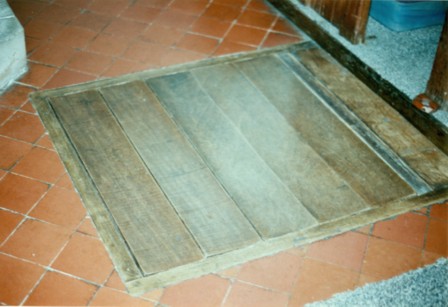
Almost as if it is being kept secret, a rug is usually placed over the hatch; but one only has to lift this to reveal a wooden compartment; pull out the two loose slats, raise the lid and you will find a deep recess in the floor which encases the sarsen megalith.
Although only the top is visible, it is a truly stunning sight.
The stone is usually wet to the touch or even has a small water puddle on it - a combination of dampness from the ground, exacerbated no doubt, by a stream that runs just a short walk away from St Mary's.
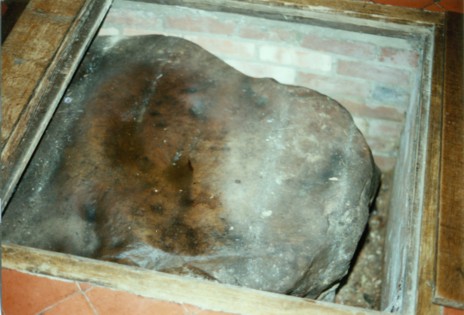
Top of the ancient stone revealed - which probably has more again below ground as on display here
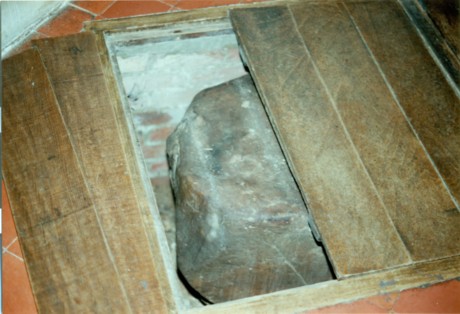
Despite its somewhat glossy appearance, in fact there is no glass covering this rock;
of course, just as with most visitors to standing stone circle sites, the natural desire is to touch the megalith and feel its wonderful cold, aged surface; was this the idea perhaps? physical contact between human and stone? It isn't difficult to imagine 'private' rituals going on here when the church was closed-off to the local folk: Old habits dying hard?
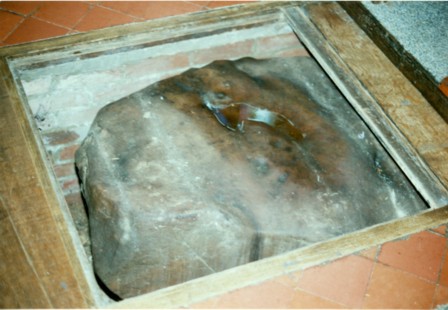
Notice the accumulation of water on the stone? Strange coincidence this, seeing as how the baptismal font is situated so close to where the stone lies hidden away.
Just a couple of hundred years ago, water taken from a small stream or a brook was considered to be 'water from the living earth'; such sources were known as a 'bournes' - as in born (from the earth).
This might seem like nonsense in our digital age, but people once held great store in nature and superstition; and to look at this another way, perhaps early beliefs were no more daft than us believing everything we see and hear on TV today, as some people do.
For instance, it was once even believed that nettles gathered on sanctified soil and boiled down for a drink, had the power to cure various ailments; and similarly, the dew gathered from graveyards was considered highly efficacious against specific maladies.
Complete balderdash one might think - but who are we to say that such 'quack' cures and beliefs are wrong and ineffective?
As with the supposed power of prayer, the power of belief might merely be case of attempting to exert mind over matter... but as we all know, sometimes miracles of faith do happen!
Finally, a word of caution here; small rural churches like this used to be open most days, but now, due to cutbacks and a spate of thefts, they are kept locked more often than not, and are usually only open for maintenance, baptisms, weddings and funerals.
We discovered this stone by sheer accident a few years back, when randomly visiting St Mary's as part of our researches, and as luck would have it, there was nobody else around; and me being the curious person that I am, it was a case of what's under that rug? and upon finding this little set up, taking a chance and photographing everything before replacing the boards and rug back to normal as quickly as possible - just in case anyone should suddenly walk in; although I'm sure if one were to seek permission first it would be granted... that is, if you can track down the vicar!
©All photos and text used on this page are the copyright of BEAMS and Ken Parsons


